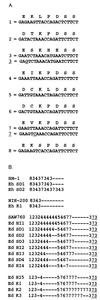Molecular epidemiology of Entamoeba spp.: evidence of a bottleneck (Demographic sweep) and transcontinental spread of diploid parasites
- PMID: 11015408
- PMCID: PMC87481
- DOI: 10.1128/JCM.38.10.3815-3821.2000
Molecular epidemiology of Entamoeba spp.: evidence of a bottleneck (Demographic sweep) and transcontinental spread of diploid parasites
Abstract
Entamoeba histolytica causes amebic colitis and liver abscess in developing countries such as Mexico and India. Entamoeba dispar is morphologically identical but is not associated with disease. Here we determined the ploidy of E. histolytica and developed PCR-based methods for distinguishing field isolates of E. histolytica or E. dispar. Fluorescence in situ hybridization showed that E. histolytica trophozoites are diploid for five "single-copy" probes tested. Intergenic sequences between superoxide dismutase and actin 3 genes of clinical isolates of E. histolytica from the New and Old Worlds were identical, as were those of E. dispar. These results suggest a bottleneck or demographic sweep in entamoebae which infect humans. In contrast, E. histolytica and E. dispar genes encoding repeat antigens on the surface of trophozoites (Ser-rich protein) or encysting parasites (chitinase) were highly polymorphic. chitinase alleles suggested that the early axenized strains of E. histolytica, HM-1 from Mexico City, Mexico, and NIH-200 from Calcutta, India, are still present and that similar E. dispar parasites can be identified in both the New and Old Worlds. Ser-rich protein alleles, which suggested the presence of the HM-1 strain in Mexico City, included some E. histolytica genes that predicted Ser-rich proteins with very few repeats. These results, which suggest diversifying selection at chitinase and Ser-rich protein loci, demonstrate the usefulness of these alleles for distinguishing clinical isolates of E. histolytica and E. dispar.
Figures





References
-
- Acuna-Soto R, Samuelson J, de Gerolami P, Zarate L, Schoolnik G, Millan-Velasco F, Wirth D. Application of polymerase chain reaction to the epidemiology of pathogenic and nonpathogenic Entamoeba histolytica. Am J Trop Med Hyg. 1992;48:58–70. - PubMed
-
- Anders R F, McColl D J, Coppel R L. Molecular variation in Plasmodium falciparum: polymorphic antigens of asexual erythrocyte stages. Acta Trop. 1993;53:239–253. - PubMed
-
- Blanc D, Sargeaunt P G. Entamoeba histolytica zymodemes: exhibition of δ and γ bands only of glucose phosphate isomerase and phosphoglucomutase may be influenced by starch content in the medium. Exp Parasitol. 1991;72:87–90. - PubMed
-
- Bruchhaus I, Leippe M, Lioutas C, Tannich E. Unusual gene organization in the protozoan parasite Entamoeba histolytica. DNA Cell Biol. 1994;12:925–933. - PubMed
-
- Bub H, Lioutas C, Dobinsky S, Nickel R, Tannich E. Analysis of the 170-kDa lectin gene promoter of Entamoeba histolytica. Mol Biochem Parasitol. 1995;72:1–10. - PubMed
Publication types
MeSH terms
Substances
Grants and funding
LinkOut - more resources
Full Text Sources
Miscellaneous

